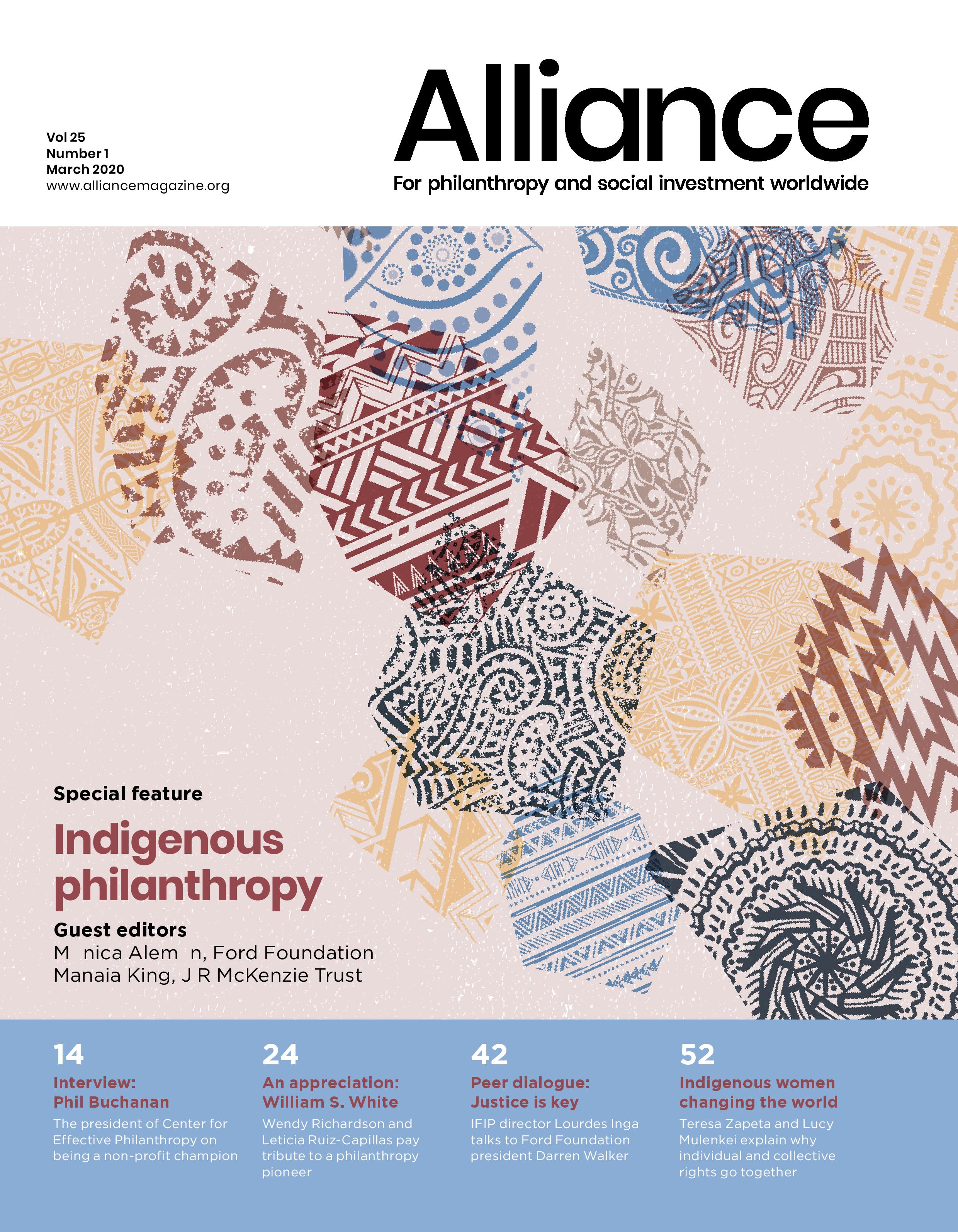For Indigenous women, there is no distinction between individual and collective rights. How can philanthropy help them achieve those rights and where are the challenges?
Indigenous women are part of ancient civilisations, culturally diverse and present in different regions of the world. According to the information shared in the Food and Agriculture Organization of the UN webpage[1], Indigenous women total approximately 185 million worldwide, belonging to more than 5,000 Indigenous Peoples.
That said, it is worth underlining that there isn’t specific quantifiable data on Indigenous women due to the lack of ethnic and gender disaggregation in official statistics. However, it’s clear that the inequalities in the world become deeper in the case of Indigenous women. The UN Development Programme’s 2014 Human Development Report[2] states that Indigenous Peoples represent 15 per cent of those living in poverty, categorising this as a violation of the right to social, economic and political development.
We are not first women and then Indigenous or vice versa, we are all one, individual and collective.
These realities and the demands to change them are summarised in the Lima Plan of Action, a global agenda adopted by delegates from seven socio-cultural regions of the world in Lima, Peru, launched at the World Conference of Indigenous Women (2013), which will be reviewed and updated during the Second World Conference of Indigenous Women (2020).
We, as part of the Indigenous women’s movement, actively participate in other movements, such as those of trade unionists, environmentalists and feminists and other movements of Indigenous Peoples.
Working in solidarity with other feminist movements has helped advance the cause of Indigenous women. The Fourth World Conference on Women of the United Nations, held in Beijing (1995), is a good example. This was a crucial milestone in the global articulation of the role and identity of Indigenous women, thereby beginning the creation of the International Indigenous Women’s Forum (FIMI).
In the same way, in the Indigenous women’s movement, individual rights don’t eclipse or take precedence over collective rights, but the two enhance and interact with each other; highlighting and stimulating campaigns against poverty, malnutrition, violence, environmental pollution, dispossession of territories and forced evictions, among others. We are not first women and then Indigenous or vice versa, we are all one, individual and collective. As Indigenous women, therefore, we have contributed to the struggle for access to education, health and other public services as individual rights. At the same time, we have fought for quality services, which have cultural relevance for us, with content in our Indigenous languages and based on the wisdom of our ancestors as part of our collective right. This reflects in our collective political participation, our advocacy and in our political papers at different levels.
The fund has looked at how this complementarity of resources has worked in practice, by identifying and quantifying the contributions of Indigenous women in each process or project.
On the threshold of a new decade and within the framework of Beijing + 25, some challenges remain for Indigenous women, highlighted by the Global Survey launched by FIMI in September 2019 involving Indigenous women from 45 countries. Its findings focus on increasing violence against women and girls, including human trafficking and sexual violence, as well as criminalisation and murders of Indigenous women’s defenders, the lack of public policies and specific budgets to deal with the realities of Indigenous women and under-representation in decision-making spaces at all levels.
Another great challenge and therefore one of the priorities of Indigenous women is economic empowerment and autonomy based on their own vision and traditions. This involves access to development opportunities and urgent access to technical, financial, human and professional resources. Indigenous women from 15 African countries, participating in the African Regional Preparatory Meeting Beijing +25, which took place in Yaounde, Cameroon in November last year said that none of their organisations had received resources from their states for the development of their human rights. Why? One of the main reasons is that most states do not recognise them as having rights. Many highlighted that institutionalised discrimination and marginalisation still exist.
This is where the philanthropic community could intervene, discussing together with Indigenous women effective forms of partnership for development, to move from a vertical, ‘aid’ perspective towards the complementary use of resources, skills and reciprocity in knowledge to challenge and transform systems that perpetuate inequality.
Drawing on the experience of 197 Indigenous women’s organisations from different regions of the world, at AYNI-FIMI Indigenous Women’s Fund, we have brought together our resources for organisational strengthening, leadership and advocacy, capacity building in fund management, territory protection and natural resources, climate change mitigation and violence prevention. In this way, the philanthropic arm of FIMI advocates the end of the paradigm of funding as charity.
Indigenous women believe in co-investment. Not the kind that generates profits, but the co-investment that produces the transformation of inequalities.
The fund has looked at how this complementarity of resources has worked in practice, by identifying and quantifying the contributions of Indigenous women in each process or project. Looking at their ancestral knowledge, we take into account their organisational spaces, spirituality, languages, and use of time. For example, the fund co-invests in the spiritual resources of Indigenous women on equal terms with human or economic resources.
These are good practices that have led us to unlearn many years of colonisation which forced us to internalise ways inappropriate to our traditional culture, which in turn, has led to our devaluing ourselves. Thus, our participation with other funds and donors helps us to see our practices in terms of reciprocity.
Reciprocity is a key concept. It implies trust and recognition of Indigenous women as actors of change and its practise has allowed us to strengthen our capabilities. For 2020, we have instruments and tools that enable us to manage and make decisions about our resources and those that are managed on our behalf. Indigenous women believe in co-investment. Not the kind that generates profits, but the co-investment that produces the transformation of inequalities. In the Maya K’iche language, it is defined as the Kuchuj, the pooling of resources for the well-being of everyone.
Teresa Zapeta is executive director of the International Indigenous Women’s Forum (FIMI).
Email: teresa-z@iiwf.org
Twitter: @teresazapetam
Lucy Mulenkei (Masai from Kenya) is founder and vice-president of the FIMI Board.
Email: mulenkei@gmail.com
Featured image provided by Samburu Women Trust
Footnotes
- ^ www.fao.org/indigenous-peoples/indigenous-women/en/
- ^ Human Development Report 2014: Sustaining Human Progress: Reducing Vulnerabilities and Building Resilience, available at: http://hdr.undp.org/sites/default/files/hdr14-report-en-1.pdf






Comments (0)